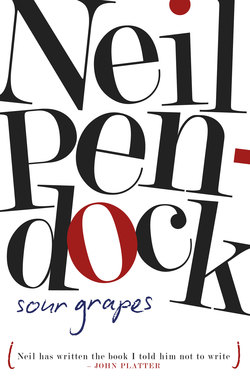Читать книгу Sour Grapes - Neil Pendock - Страница 4
На сайте Литреса книга снята с продажи.
Introduction
Оглавление‘Listen, all you need to take is a lipstick
and I two bottles of wine’
(Breyten Breytenbach, In a Cab in the Rain, New York)
Kitchen potboilers are suddenly in season: Marco Pierre White spilt much more than the beans in White Slave (Orion, 2006), while Anthony Bourdain didn’t disappoint with The Nasty Bits (Bloomsbury, 2006). My favourite was Heat (Knopf, 2006) by Bill Buford and the subtitle explains why: ‘An amateur’s adventures as kitchen slave, line cook, pasta-maker and apprentice to a Dante-quoting butcher in Tuscany.’
For Bill, whose day job is writing for The New Yorker, can certainly write and he’s a true amateur in the original sense of the word – someone who does it for love.
In South Africa, so-called professionals, self-appointed bibulous boffins, sacred cows, or moos (masters of olfactory subjects they never taught you at university) and wine insiders attempt to achieve status by putting down amateurs and the result is as obvious as a wine lake or a muf bottle of Crouchen Blanc. From serious side effects, like South African wine consumption on a relentless downward spiral, to fear of ordering wine in a restaurant in case of committing a social faux pas, snobbishness about wine is silly and suburban.
Far too many South African commentators are alternately barkers and shills or paid purveyors of PR-speak, the lingua franca of a profession described by Sunday Times restaurant reviewer, AA Gill, (‘Britain’s most waspish and possibly best-paid critic’, according to The Guardian) as ‘the headlice of civilisation’. But perhaps even worse, they’re usually pompous and boring.
A couple of years ago, Nederburg came up with an initiative to make a blended wine to be sold at the annual Nederburg Auction, with the proceeds nobly given to charity. The name of the blend was Nederburg Amateur, recognising the passion that wine lovers feel for the fermented fruit of the vine. While the Fourth Estate assembled the blend, in this case a more worthy constituency would have been people who drink wine and even pay for it themselves, like the members of the 50 wine clubs who enter the annual Blaauwklippen Blending Competition, now in its third decade. The 2006 winning red blend was made by Amanda de Vos of the Knysna Wynproe gilde, while the 2007 was assembled by Roland Frost from the Symposia Wine Society in Durban, who, refreshingly, ‘just threw the Cabernet and Malbec together in equal proportions to get 70 per cent and then added the Shiraz and Cabernet Franc’.
When it comes to writing about the fermented fruit of the vine, amateurs certainly have a clear edge over the pros. One of America’s hippest novelists, Jay McInerney, is also her finest wine writer. Online lifestyle magazine Salon.com calls him ‘the best wine writer in America’. The author of the novel that nailed the hedonistic excesses of eighties Manhattan, Bright Lights, Big City, latterly turned wine columnist for House & Garden, is more bashful. Jay describes himself as ‘a passionate amateur’ who employs ‘a metaphoric language’ in comparing wines to ‘actresses, rock bands, pop songs, painters or automobiles’, rather than a ‘literal parsing of scents and tastes’ à la Platter’s, the wine guide that annually features in the list of South African non-fiction best-sellers.
Jayspeak has a definite louche flair, dating back to his days as a cocaine novelist from the Reagan era. Take his definition of Botrytis, the beneficial fungus that desiccates grapes and produces the concentrated marvels of Sauternes: ‘Not since Baudelaire smoked opium has corruption resulted in such beauty.’ Or his rule of thumb for separating Burgundy from Bordeaux: ‘If it’s red, French, costs too much, and tastes like the water that’s left in the vase after the flowers have died and rotted, it’s probably Burgundy.’
South Africa’s own Burgundy boffin, Anthony Hamilton Russell, recounts Jay cooking him and his wife a perfect steak in his Manhattan apartment, with F. Scott Fitzgerald’s desk in the study, a present from one of his many wives. Which is quite appropriate, given that Jay McInerney could be mistaken for Jay Gatsby, the hero of Fitzgerald’s masterpiece, The Great Gatsby, as a result of his sharp dressing and hedonistic lifestyle, flying around the world to eat medieval Kyoto cuisine paired with vintage Dom Pérignon. And in his documentation of the fashionable edge, McInerney is the F. Scott Fitzgerald de nos jours.
Even the wine professionals think he’s great, with America’s über-palate, Robert Parker, calling him ‘brilliant, witty, comical and often shamelessly candid and provocative’.
Jay’s own winespeak hero and role model is the late Auberon Waugh, who’d certainly get my vote for best wine writer of the last millennium. His comment on the perils of being a wine hack supplies reason enough:
‘Wine writing should be camped-up. The writer should never like a wine; he should be in love with it; never find a wine disappointing but identify it as a mortal enemy, an attempt to poison him; sulphuric acid should be discovered when there is the faintest hint of sharpness. Bizarre and improbable side tastes should be proclaimed: mushrooms, rotting wood, black treacle, burned pencils, condensed milk, sewage, the smell of French railway stations or ladies’ underwear.’
After all, what would you rather hear over dinner – the ghost of Auberon (‘Red, I should say. And very nice.’) or a discussion on whether that spicy character that everyone enjoyed ‘had notes of Brett or Geosmin’ (think ‘beetroot’)?
What follows is my attempt at an amateur’s overview of South African wine: opinionated, outrageous and over the top. Cheers!
